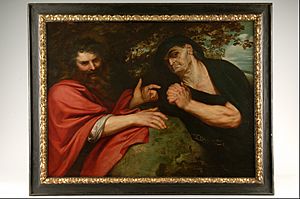Heraclitus and Democritus (Rubens) facts for kids
Heraclitus and Democritus is a famous painting created by the Flemish artist Peter Paul Rubens. He painted it in 1603 while he was staying in Spain. The painting was made for the Duke of Lerma.
Today, you can see this artwork at the National Sculpture Museum in Valladolid, Spain. The painting shows two important ancient Greek thinkers: Heraclitus and Democritus.
Contents
About the Painting
Who Were Heraclitus and Democritus?
Heraclitus and Democritus were ancient Greek philosophers. They lived a very long time ago, around 500 BC. Philosophers are people who think deeply about life, knowledge, and the world.
Heraclitus was known as the "weeping philosopher." He believed that everything in the world was always changing. He thought that change was the only constant thing. He often seemed sad about the world's problems.
Democritus was called the "laughing philosopher." He believed that everything was made of tiny, unseen particles called atoms. He thought that life was something to be enjoyed. He often seemed happy and cheerful.
Rubens' Artistic Style
Peter Paul Rubens was a very famous painter from Flanders (which is now part of Belgium). He lived from 1577 to 1640. Rubens was known for his exciting and dramatic paintings. His style is called Baroque art.
Baroque art often uses strong colors, lots of movement, and deep emotions. Rubens was very good at showing feelings in his paintings. He also painted many different subjects, like history, myths, and portraits.
Where Was it Painted?
Rubens painted Heraclitus and Democritus in 1603. At that time, he was living in Valladolid, Spain. He was working for the Duke of Lerma, who was a very powerful person in Spain.
This painting is a great example of Rubens' early work. It shows how he was already a very talented artist, even when he was young.
See Also
- In Spanish: Heráclito y Demócrito (Rubens) para niños


